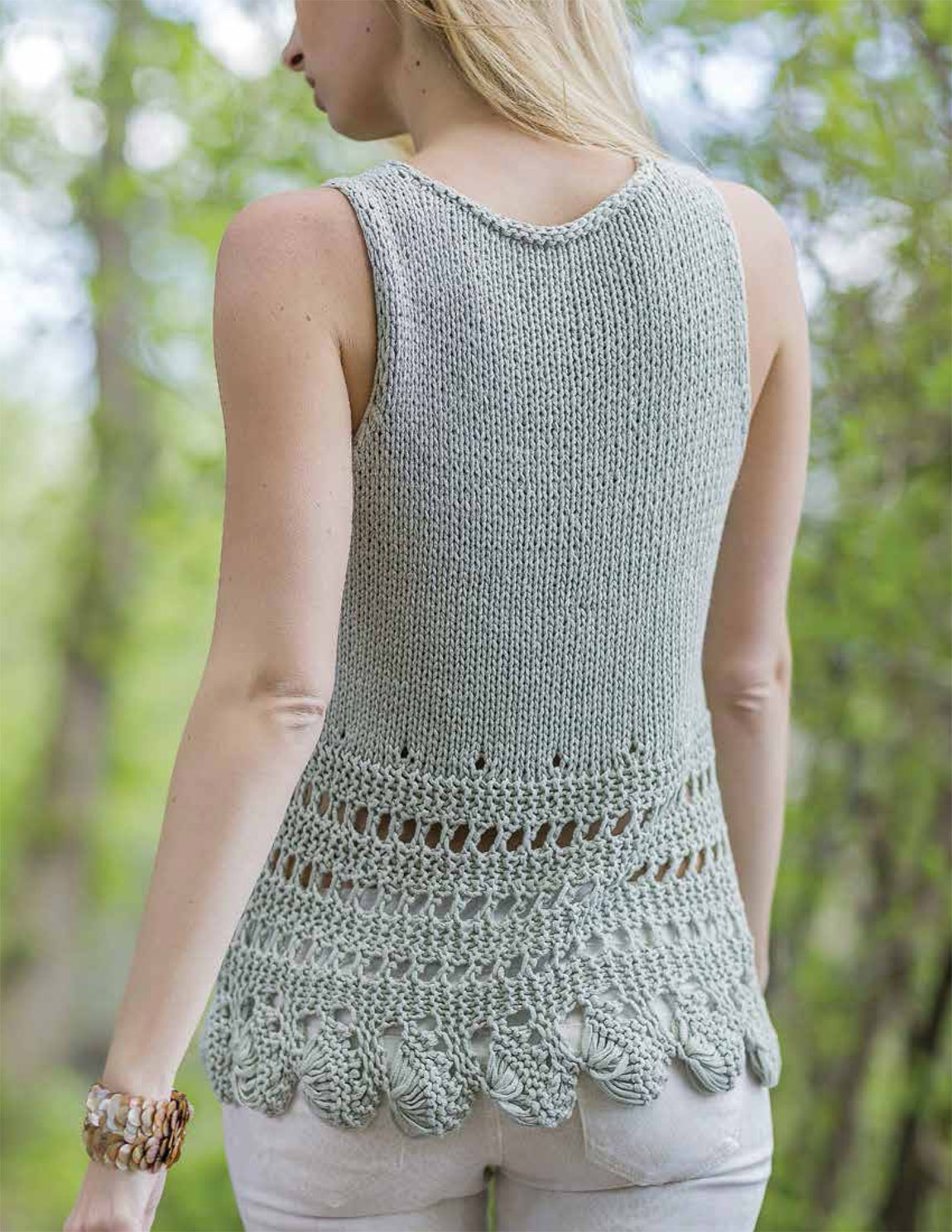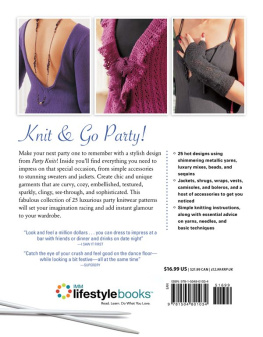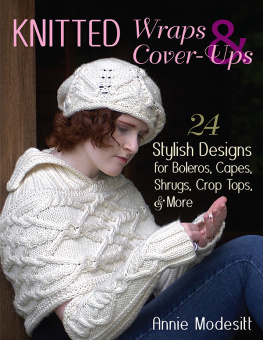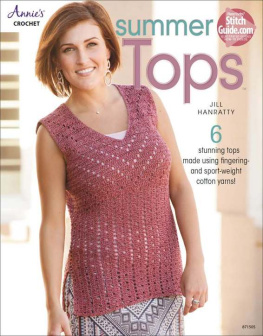Acknowledgments
I had a wonderful time working on the 21 patterns in this book, in large part because Stackpole Books and my editor, Candi Derr, allowed me great freedom in choosing yarns, designs, and even pattern names, as well as welcoming my input on photography, for which I am grateful. I am also grateful to Pam Hoenig, who approached me with the idea for this book, and provided sage advice and some very helpful yarn company contacts.
Many thanks also to Tom Moore, whose photography is stunning, and to his assistant, Christine Alicea, for allowing me to tag along (and even help) during the photo shoota fascinating and eye-opening experience.
Thanks also to Christine for hair and outfit styling, and to models Christine, Lexi Wood, and Alex Andrezen for making all of my designs look so wonderful.
The following companies generously provided yarn support:
Berroco
Blue Sky Fibers
Brown Sheep Company, Inc.
Cascade Yarns
Classic Elite Yarns
Claudia Hand Painted Yarns
Premier Yarns
Quince & Co.
Rowan
Schachenmayr
Schoeller + Stahl / LoveKnitting
Spinrite Yarns
Universal Yarn
Valley Yarns
Finally, thanks to my mother, for teaching me how to knit; to both of my parents, for refraining from any outward signs of concern when I decided to give up my veterinary practice to create knitting patterns; and thanks to Tom, Louis, and Joseph, for watching movies with the lights on, occasional stints as photographers and/or models, and otherwise tolerating and even encouraging the curiously obsessive business of knitwear designespecially to Tom, my most enthusiastic promoter.

Knitted
tanks & tunics
Published by Stackpole Books
An imprint of The Rowman & Littlefield Publishing Group, Inc.
4501 Forbes Blvd., Ste. 200
Lanham, MD 20706
Distributed by
NATIONAL BOOK NETWORK
800-462-6420
Copyright 2018 by Angela Hahn
Photography: Tom Moore Studios (model photos) and Angela Hahn (technique photos)
All rights reserved. No part of this book may be reproduced in any form or by any electronic or mechanical means, including information storage and retrieval systems, without written permission from the publisher, except by a reviewer who may quote passages in a review.
The contents of this book are for personal use only. Patterns contained herein may be reproduced in limited quantities for such use. Any large-scale commercial reproduction is prohibited without the written consent of the publisher.
We have made every effort to ensure the accuracy and completeness of these instructions. We cannot, however, be responsible for human error, typographical mistakes, or variations in individual work.
British Library Cataloguing in Publication Information Available
Library of Congress Cataloging-in-Publication Data
Names: Hahn, Angela, author.
Title: Knitted tanks & tunics : 21 crisp, cool designs for sleeveless tops / Angela Hahn.
Other titles: Knitted tanks and tunics
Description: Guilford, Connecticut : Stackpole Books, 2018.
Identifiers: LCCN 2017055454 (print) | LCCN 2017060327 (ebook) | ISBN 9780811767545 (e-book) | ISBN 9780811717977 (pbk. : alk. paper)
Subjects: LCSH: Knitting--Patterns. | Women's clothing.
Classification: LCC TT825 (ebook) | LCC TT825.H25626 2018 (print) | DDC
746.43/2--dc23
LC record available at https://lccn.loc.gov/2017055454
 The paper used in this publication meets the minimum requirements of American National Standard for Information SciencesPermanence of Paper for Printed Library Materials, ANSI/NISO Z39.48-1992.
The paper used in this publication meets the minimum requirements of American National Standard for Information SciencesPermanence of Paper for Printed Library Materials, ANSI/NISO Z39.48-1992.
Printed in the United States of America

Introduction
An entire sweater can be a daunting project, especially for a novice knitter. The sheer amount of knitting, combined with the need for shaping and fitting, can be discouraging. Even an experienced knitter may hesitate to begin a sweater pattern that uses a fine gauge yarn, a complicated allover stitch or color pattern, or complex shaping (or all three)no matter how appealing the dessign may be.
That is one reason I love sleeveless knits: without the sleeves, a sweater suddenly seems like a much more manageable project. A sleeveless top may actually be less knitting than a scarf, and no more complicated than a hat. Use a medium or bulky weight yarn, and you may be surprised by how fast your work progresses.
On the other hand, the fact that a sleeveless top requires less knitting than a complete sweater means that it is a great way to try out sport or fingering weight yarns, stitch patterns like cables or lace, or just-for-fun short row shaping, without committing to a weeks- or months-long knitting odyssey.
Another reason that I love sleeveless knits is that they are versatile to wear: they can be dressy or casual, sexy or sedate, and worn by themselves, layered over another top, or used as a shell under a cardigan or jacket. Although these patterns are geared toward warm weather knitting, and mostly use cotton or cotton-blend yarns, some of these designs could instead be worked in an extrafine merino, silk, or cashmere blend, and be equally at home in the office or at a holiday party.
A word of caution: There is nothing more disappointing than spending the time to knit a garment, only to find out that it doesnt fit. So please take the time to read the section on Making Sure Your Knits Fit, and dont skip the gauge swatch, especially if you are substituting yarns!
Ive used many different types and weights of yarns, and included a wide range of styles, fits, and knitting techniques, within the 21 designs in this book. The patterns also range in difficulty from Beginner to Experienced, with most falling in the Easy to Intermediate range. The many settings in which the models were photographed, from shore to garden to village to city, demonstrate the versatility of sleeveless tops, and inspired the pattern names (all are American towns of various sizes and locations).
I had a lot of fun creating these designs, and I hope you enjoy knitting them!
Making Sure
YOUR KNITS FIT
Its frustrating to spend a lot of time knitting something and then realize that it doesnt fit very wellespecially when its a garment that (like most of the designs in this book) is intended to fit fairly closely to the body. Patterns are written to fit a limited number of standard sizes, but these are averages for different body dimensions, and only a lucky few knitters will actually be a standard size.
How Patterns Are Sized
The Craft Yarn Council has published a chart of womens sizes that is often used as a basis for sizing knitting patterns. The bust circumference is used as the index measurement, and starts at 2830/7176 cm for X-Small (XS) and increases by 4/10 cm for each subsequent size: Small (S) is 3234/8186 cm, Medium (M) is 3638/91.596.5 cm, Large (L) is 4042/101.5 106.5 cm, Extra Large (1X) is 4446/111.5117 cm, 2X Large (2X) is 4850/122127 cm, 3X Large (3X) is 5254/132137 cm, 4X Large (4X) is 5658/142147 cm, and 5X Large (5X) is 6062/152158 cm. These measurements refer to body dimensions, not garment measurements (for more on this, see the section below on Ease).
But there are many other body dimensions that can be equally important when fitting a garment, such as waist circumference, hip circumference, back waist length (length from the base of the neck to the natural waist), cross back (shoulder to shoulder width), upper arm circumference, and sleeve length (length from armpit to cuff)and the more of these measurements you consider, the less likely it will be that you fit one of the standard sizes perfectly. That is why, to get a well-fitted hand knit, you need to understand 1) how to choose the best pattern size for you, 2) how to make any changes to the pattern, preferably before you start knitting, to alter the finished dimensions to best fit your body, and 3) how to ensure that the dimensions of the finished garment match those specified in the pattern (original or with your changes).






 The paper used in this publication meets the minimum requirements of American National Standard for Information SciencesPermanence of Paper for Printed Library Materials, ANSI/NISO Z39.48-1992.
The paper used in this publication meets the minimum requirements of American National Standard for Information SciencesPermanence of Paper for Printed Library Materials, ANSI/NISO Z39.48-1992.